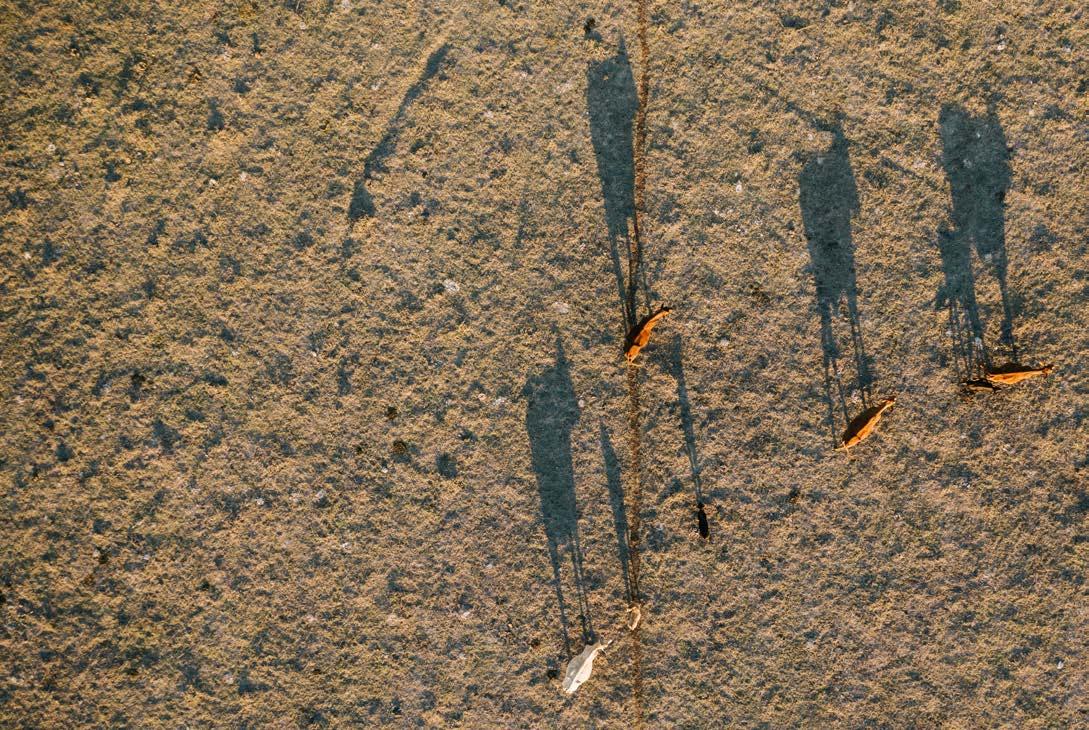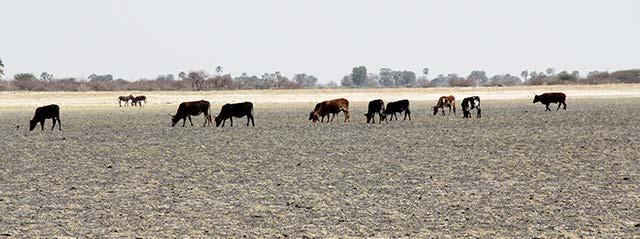
6 minute read
Guidelines for livestock production during the drought
from ProAgri BNZ 15
by ProAgri
Drought is the livestock farmer’s worst nightmare, especially if he is relying on natural pastures only to feed his animals. Here are a few guidelines to help you mitigate the effects of scarce grazing material (natural pasture) on veld due to drought.
The following guidelines may help to prevent mortalities and reduce financial losses:
Advertisement
• Ensure that cash flow is maintained judiciously. • Safeguard the core breeding livestock. After the drought, these females must generate income again. • Where still possible, provide strategic supplementary feeding on the veld. • Reduce the number of livestock that are dependent on feed sources on the farm by selling surplus animals or temporarily removing them from the veld to a kraal or planted pasture. • Restrict movement of livestock by confining them to small paddocks with shade trees or other protection from the elements. This provides better control over the quantities of feed provided daily to the animals. • Ensure that all animals have free access to clean drinking water. • Separate the stronger and weaker animals to reduce competition at the feed troughs. Prevent thin livestock, especially cattle, from becoming too emaciated and lie down because of poor feeding conditions. Do not feed animals ad lib over a long period. Ration the feed according to the required production levels, for example survival or maintenance (maintain body mass) or lactation. Do not waste feed by tossing it onto the ground – use appropriate feed troughs or conveyor belts. Provide the rationed feeds every second or third day. Most animals will receive enough feed if you do so. It will also reduce competition at the feed troughs. What can be fed? The basis for ruminants is roughage, be it on the veld or in the trough. Coarsely ground roughage is always better utilised (less waste) than in the long form. The energy content can be increased with an appropriate source (for example ground maize) and balanced with an appropriate crude protein source. The intake of minerals is then balanced according to the requirements of the animals. Feed pellets are merely convenient (transport, handling, less waste) but coarsely ground roughage

(properly balanced) can adequately meet the requirements of animals. Restrict the daily intake of salt (NaCl) for sheep to 5 to 10 g and cattle to 50 to 60 g.
Core herds/flocks
• Herds/flocks must be grouped according to age and production status. Determine pregnancy in cattle as soon as possible after the current mating season. With sheep and goats, females can be scanned to determine if they carry twins/ triplets to adjust their nutrition level. • In addition to pregnancy, the condition of teeth must also be assessed, especially for older cows and ewes. Pregnant cows must still be able to graze until the next calving and specifically be able to wean the unborn calf. Females with worn teeth can still complete their production in a kraal, but this practice will carry a price tag. • Create an inventory of all available veld and other feed sources. This information is needed to determine the number of animals that can be maintained well into and after the next summer. dependent on the feed sources by marketing surplus animals or removing them temporarily from the veld. Note the reproduction records and weaning mass of the progeny of females. In each age class, the less productive animals must be culled. losses” applies and all expenses must be weighed and discounted against expected income over the short to medium term. Take caution against selling younger breeding animals at a premium because they are in good condition and pregnant. You will need them later on. any changes in the internal and external parasite control.
General
The situations of farmers differ – seek professional assistance with strategic planning. When grazing material on the veld is scarce, animal licks will not help – often too much supplementary feeding is provided under such conditions on the veld. Decide in good time when to remove animals from the veld and feed them strategically in small paddocks. Plant material may still be available along roads and can be cut and baled. Thornless prickly pear leaves can also be used as a good feed source – whole cladodes for cattle and coarsely chopped cladodes for sheep and goats. During droughts we cannot be too choosy about the quality of feed sources which can mean the difference between life and death for livestock. If poor quality roughage such as veld grass hay or crop residues or cactus pear cladodes are available, animal nutritionists can use it as a basis to formulate diets to meet the minimum requirements of livestock.
The ruminant
The plant material selected during
Reduce the number of animals The principle of “cutting your Seek veterinary advice regarding

droughts on poor and dry veld contains little crude protein. The digestive system of ruminants and the symbiosis with microbes in the reticulo-rumen offer the opportunity to supplement crude protein with a non-protein nitrogen (NPN) source such as feed grade urea. The microbes in the reticulo-rumen break down cellulose (fibre) and produce new nutrients (volatile fatty acids and microbial protein). The complex four compartment “stomach” develops gradually from the suckling phase (basically still monogastric) to that of a physiological mature ruminant. In younger calves and lambs/kids the reticulo-rumen is still in the process of developing. Therefore, it is better to use natural and higher quality protein sources instead of NPN; bypass protein may also be supplied strategically.
Supplementary feeding (licks)
It is important to address some critical questions regarding a supplementary feeding programme. • What is the aim with the supplementation? Must protein, energy, a combination of protein and energy, or minerals be supplemented? Should animals gain condition or must dry animals maintain mass (maintenance) or must lactation be supported? Animals in different production phases require specific types and quantities of strategic supplementary feeding. How can the aim be achieved best? Have the less productive animals been removed to make all grazing available for the remaining livestock? This option is still not used to the best advantage and can make a huge contribution to improve efficacy and also lower the cost of supplementary feeding to the remaining animals. Can it be ascertained whether the aim has been reached? Most well-intended programmes to improve animal performance fail in this regard, because the recommended level of supplementation is seldom achieved. Intake of supplementary feeding varies and is affected by feeding space (number of animals per trough), access to troughs (dominance between animals), level of supplementation and how often the troughs are being re-filled. Unless the provision of supplementary feeding is managed, some animals will consume too much while others ingest too little to benefit at all. Do not feed animals aimlessly on the veld. A range of products are available. Seek advice from a professional animal nutritionist regarding the options and products to be considered. Animals may experience a moderate loss (10 to 15%) in body mass, but then only over a relatively long period and under control of judicious feed management.
In closing
Production and reproduction of cattle is usually lower during droughts, and animals get sick more easily – the extent will depend on the severity of the drought conditions. Lactating cows, late pregnant heifers and weaners are the most vulnerable, because of higher nutrient requirements. A thorough understanding of these factors are needed for a cost-effective management strategy to mitigate the effects of droughts on animal production, reproduction, and health.
Article compiled by Prof HO de Waal Pr. Sci. Nat., Anim. Sci., Department of Animal, Wildlife and Grassland Sciences, University of the Free State, e-mail: deWaalHO@ ufs.ac.za.










